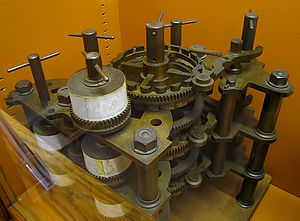 Part of the Difference Engine. Image via WikipediaOne hundred and forty years ago today, on 18 October 1871, Charles Babbage died.
Part of the Difference Engine. Image via WikipediaOne hundred and forty years ago today, on 18 October 1871, Charles Babbage died.Born in 1792, this English mathematician and inventor is known as a pioneer of modern-day computing, and is credited with conceiving the concept of a programmable computer. He developed an obsession for mechanising computation, in order to eliminate inaccuracies in mathematical tables. By 1822, he had developed a small calculating machine able to compute squares. He then produced prototypes of a larger Difference Engine.
In the 18th century, numerical tables were calculated by humans who were known as 'computers'. While at Cambridge, Babbage saw the high error rate involved in this human process and realised the potential for the work to be mechanised. In 1822 he began to develop the Difference Engine, firstly to compute values of polynomial functions. By using the method of finite differences, it was possible to avoid the need for more complicated multiplication and division operations, hence the machine’s name.
However, the Difference Engine was never finished, despite no shortage of funding for the project, neither was the successor he designed “Difference Engine Number 2”. The first difference engine would have been composed of around 25,000 parts, weighed 13,600 kg, and been 2.4 m tall.
During Babbage’s lifetime, the Swedish engineer Per Georg Scheutz and his son Edvard constructed the first working models of the Difference Engine. They used Babbage’s design and it was successfully deployed in certain applications, primarily printing tables of logarithms.
While the Difference Engine would have been capable of making calculations, had he completed it, Babbage’s most ambitious work began in 1833 when he started to develop his programmable Analytical Machine. If the Difference Engine is to be compared with today’s pocket calculator, the Analytical Engine can be considered the first mechanical computer, a forerunner of all programmable computers.
In fact, the Analytical Engine was not a single machine but a succession of designs that Babbage modified until his death in 1871. The Analytical Engine could be fed punched cards, whose patterns of holes contained programming instructions, a system that survived until the 1970s in modern computers.
The programs stored on the cards were created initially by a person, and then fed into the machine for processing. The analytical engine would have used loops of punched cards to control a mechanical calculator, which could formulate results based on the results of previous calculations. The engine would also use several features used in modern computers, such as sequential control, branching, and looping.
The mathematician Ada Lovelace, was one of the few people who appreciated Babbage's work, and formulated a program for the Analytical Engine, which would have been able to calculate a sequence of Bernoulli numbers, had the machine ever been built. Because of her work, Lovelace is now thought of as the world’s first computer programmer and the modern programming language Ada was named after her.
Charles Babbage made many other inventions, some of which now seem utterly bizarre. Some of the more practical ideas, however, include the standard railroad gauge, uniform postal rates, occulting lights for lighthouses and Greenwich time signals.
Later in life, Babbage became a bitter and bad-tempered old man. He especially hated street performers, who he blamed for depriving him of a quarter of his working potential.
Parts of Babbage’s uncompleted mechanisms are on display in London's Science Museum. There, in 1991, a perfectly functioning difference engine, modelled on "Difference Engine Number 2" was constructed from Babbage's original plans. Built only using tolerances achievable in the 19th century, the performance of the completed engine indicated that Babbage's machine would have worked. It performed its first calculation to 31 digits, far more than the average modern pocket calculator.
Nine years later, the Science Museum finished building a working model of the printer Babbage had designed for the difference engine, an remarkably complex device for the 19th century.
The modern world and its age of computers owes a huge amount to Charles Babbage, the Victorian engineer and mathematician. As Isaac Newton once said (in a different context) we are "standing on the shoulders of giants".
No comments:
Post a Comment
Note: only a member of this blog may post a comment.